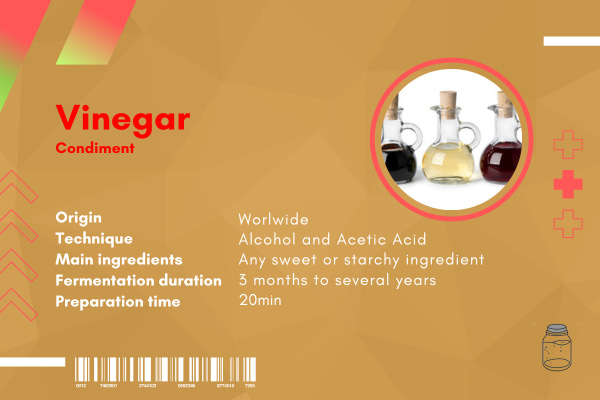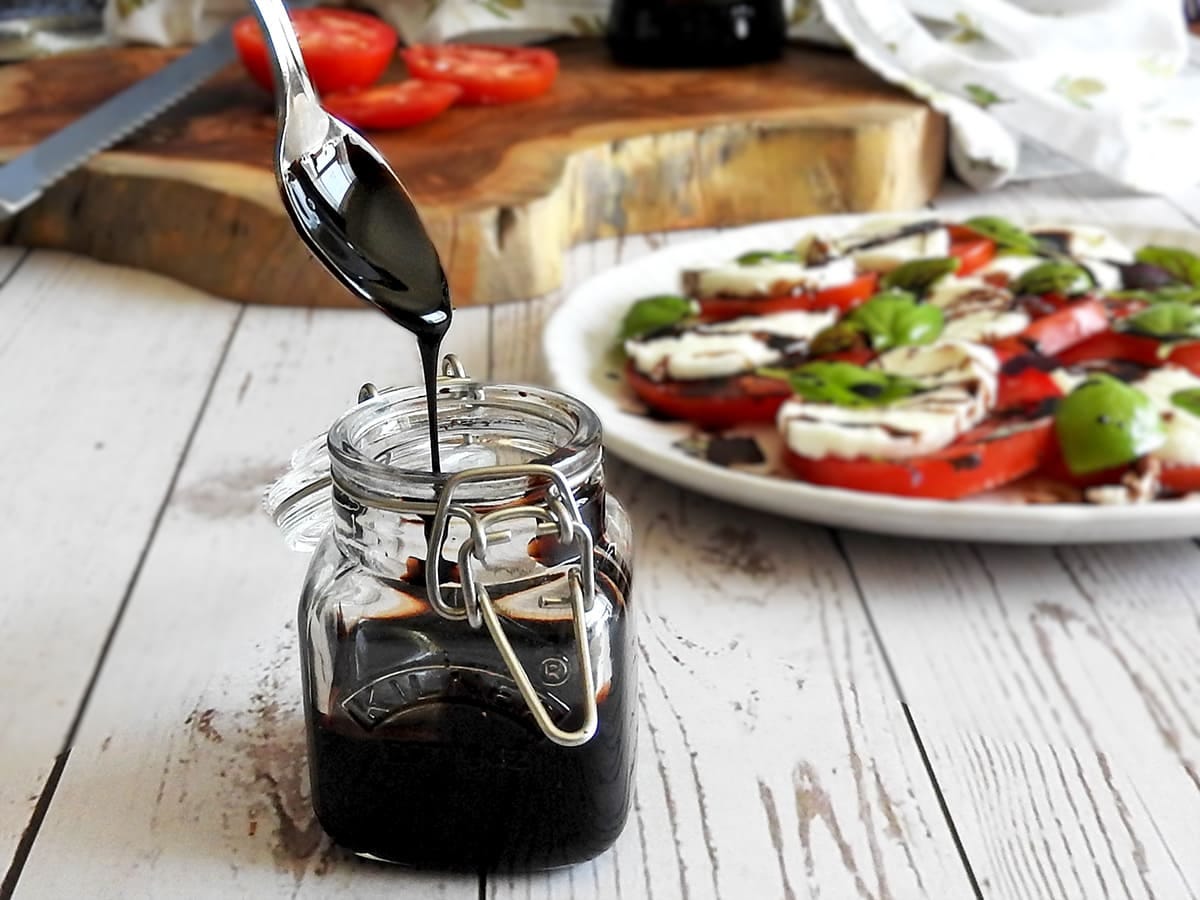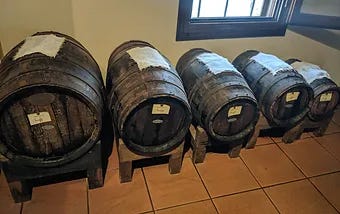Vinegar - An overlooked flavor creator
Vinegar is often taken for granted and we don't take the time to look behind the most popular types: white vinegar and apple cider vinegar.
Why to talk about vinegar?
Hi, nice to find you back! This week I choose to dig into vinegar because it’s a product that has a lot of diversity and it’s not commonly known as the selection of vinegar we can find in grocery stores is quite limited.
By knowing how vinegar is produced, you will realize it’s super easy to make your own and it will unlock a lot of possibilities. This time, your imagination is the main limit :)
As discussed in the previous 🍫 chocolate post, the flavors of chocolate comes from the fermentation which start by an alcoholic transformation followed by an acetic acid phase, in other words a vinegary transformation. Let’s find out why vinegar has a lot of potential to generate nice flavors! By the way, what actually are flavors?
What are flavors?
Ah, that’s a big question! And unlike taste that can be reduced to 5 different dimensions from our biology, flavors are much more complex.
Then, let’s start with the easier end: what is taste?
Taste helps us to detect safe and harmful food, and to gauge foods' nutritional value. We are biologically drawn to sweet food because it’s a sign of energy density.
In the same way our eyes have three different color receptor: red, green and blue; our mouth have 5 different food characteristics it can recognize thanks to our taste buds: sweet, salty, sour, bitter and savory.
Savory is also called umami in Japanese as it was first overlooked by western scientists and got introduced in the 20th century thanks to Japanese studies. We discussed how the umami taste is created in the soy sauce post.
What about flavor?
Well, flavor are a combination of taste, smell, texture, temperature and other psychological factors such as past experiences and the culture we grew up in.
Smell has a big influence on flavor. If you remember last time you had a flu and your nose was stuck, food certainly appeared more bland than usual.
There are a lot of compounds our nose can detect which makes for smell. The most common categories are: Aldehydes, Ketones, Esters, Terpenes, Phenols and Amines.
Fun facts
Not all mammals share the same taste modalities: some rodents can taste starch (which humans cannot), cats cannot taste sweetness, and several other carnivores have lost the ability to sense some of the five tastes discussed above.
Humans possess around 12 million olfactory receptor cells that can detect approximately 10,000 odors. And it’s not a myth that dogs have a really good smell sense. They have anything from 100 to 200 million plus receptor cells, depending on the breed, thus they can detect some 40,000 different odors!
How is vinegar made?
The underlying principle is quite simple: sugar is broken down by yeasts (one of which commonly involved is Saccharomyces Cerevisiae used in bread and alcoholic beverage making) into alcohol and CO2 (which creates the bubbles in the beer).
Then acetic acid bacteria are oxidizing alcohol into acetic acid (hence their name), CO2 and water. But to function at their best, acetic acid bacteria need oxygen. That is why wine doesn’t turn into wine vinegar as long as the bottle is closed and isolated from oxygen.
So, essentially what you need to make vinegar is sugar. Pretty easy to find!
Industrially
🕑 The time it takes to produce is between 1 to 3 days.
For once the industrial process isn’t too far from the traditional version. In most countries vinegar coming from chemical synthesis cannot be sold as cooking vinegar. The main and only ingredient is the fruit juice such as apple juice. Sometimes to avoid wasting the pulp of a fruit from which the juice has been extracted to sell as is, the pulp is mixed with water and sugar to make vinegar. To start the fermentation faster, the manufacturer adds a “mother” of vinegar in the tank which is the starter composed of yeast and bacteria (mainly acetobacter bacteria). And to create the aerobic environment (meaning with presence of oxygen) that the bacteria needs to produce acetic acid, air bubbles are supplied from the bottom of the tank.
The cool, home-made way
🕑 Home-made, vinegar takes at least 3 months to ferment fully.
To make vinegar at home, the same double step fermentation is applied. You just need to let a sweet beverage - like fruit juice for instance - turning into alcohol and in a container that allow for oxygen to come in and out so that vinegar can be produced from the alcohol. Or you can take any alcohol like wine and expose it to oxygen (but it might be the most expensive option…).
As it’s not very common for people to have a tank with a bottom air supply in their kitchen, we have no other choice than letting bacteria access oxygen through the surface of the liquid, which is why it takes longer than the industrial process.
The recipe!
As individual, we don’t all have something to make fruit juice at home, so the easiest way is to use fruits, or fruit scraps also works in a zero waste fashion :)
The steps are quite straightforward:
Fill a jar with half of the volume in chopped fruits or fruit scraps.
Add water to fill the jar up.
You have to measure how much water you add. You can put the jar on a scale before adding water.Add sugar with the proportion of 50g of sugar by liter
Put a breathable clothe on top of the jar and wait…
We have to add sugar as we don’t use pure fruit juice which would be much more concentrated in sugar. But don’t worry, after fermenting, the bacteria will have eaten all the sugar.
There is a bit of housekeeping to make sure the fermentation goes right.
Stir every few days to make sure no mold grow on the surface of the fruits
After one month, you can remove the apples with a strainer and let the liquid ferment for another month or two. This is to allow the acetic fermentation to finish.
What are the different types of vinegar?
What can we use to make vinegar?
You’ll be surprised to learn we can make vinegar with so many different ingredients. The most obvious category of ingredients are fruits as they have lot of sugar that turns easily into alcohol. But you probably know that we can make wine from rice (like sake), or potatoe (like vodka), so it also means we can make vinegar from rice and potatoe!
And there are even more stuff we can turn into vinegar:
Black beans
Tomato
Coconut water
Dates
Goji berries
In China, black vinegar is made from rice, millet, sorghum or wheat. Yes, black vinegar from rice haha! No, black magic is not necessary, the reason it that they use black rice to make this vinegar :)
What is balsamic vinegar?
Balsamic vinegar originates from the city of Modena in Italy. It is made from one specific variety of grape: the white trebbiano grapes. The freshly press juice is cooked for 12-24H to reduce by half the volume and thus concentrate the sugar content. That is why it’s texture can be quite thick. Then it undergoes the double fermentation as usual for vinegar, and then it is aged in wooden barrels exactly like wine. The ageing process can last up to 25 years! 😯
The ageing process of the vinegar is quite complex as generally 5 wooden barrels are used one after the other. Different wood type can be used such as oak, mulberry, ash, chestnut, cherry, juniper, and acacia. Every year the vinegar is transferred into the next barrel, and with time some evaporation through the wood happens, which is why from 50L of fresh vinegar the producer end up with 15L few years later. That’s another reason why balsamic vinegar is thick.
And you may ask why is it black when white grape is initially used? It turns out during the ageing process, the remaining sugar undergoes an acid catalyzed (as opposed to enzyme catalyzed) Maillard reaction.
But not all balsamic are created equal and low quality ones can be thick simply from added caramel, easier…
Health benefits
Recently there’s a hype around apple cider vinegar health benefits and new products are created claiming all sort of things (like gummies helping for weight loss). But, yes, vinegar in general can have benefits. For instance drinking a tablespoon of vinegar at the beginning of a meal will help lower the stomach acid (no surprise, vinegar’s pH is around 2.5-3) and thus will help digestion, especially in case of weak stomach acid.
According to popular medicine it can also help reduce heartburn and acid reflux.
The origins of vinegar
Vinegar certainly appeared at the same time as wine making. Indeed making mistakes is human and a forgotten jar of grape juice or a poorly closed one will turn into vinegar. By the way, "vinegar" comes from the French words "vin aigre" meaning "sour wine". It is and was used as a food preservative for example in pickles, mustard or soups. But it was also used in traditional medicine to help with digestive issues.
Credits
Apple cider vinegar full recipe video
Here is a detailed recipe for apple cider vinegar






